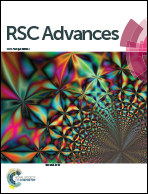Synthesis and enhanced photocatalytic activity of a BiOI/TiO2 nanobelt array for methyl orange degradation under visible light irradiation
Abstract
A novel heterojunction by facet coupling of BiOI onto TiO2 nanobelt arrays (NBAs) as a visible light photocatalyst was achieved through a hydrothermal method. The BiOI/TiO2 heterojunction had been investigated by scanning electron microscopy (SEM), transmission electron microscopy (TEM), X-ray diffraction (XRD), X-ray photoelectron spectra (XPS), UV-Vis diffuse reflectance spectroscopy (DRS), photoluminescence (PL) spectroscopy and electrochemical techniques. The BiOI/TiO2 heterojunction presented a significantly enhanced photocatalytic performance in degrading methyl orange (MO) under visible light irradiation. The obviously reduced electron–hole recombination rates of BiOI/TiO2 were demonstrated from PL spectroscopy measurements and the photoelectrochemical evaluation. The 2-BiOI/TiO2 NBAs sample displays the highest photocatalytic activity toward the degradation of the MO solution under visible-light irradiation, corresponding to an apparent pseudo-first-order rate constant kapp of 0.0973 min−1. It is 5 times more than that of a pure TiO2 nanobelt array photocatalyst.


 Please wait while we load your content...
Please wait while we load your content...